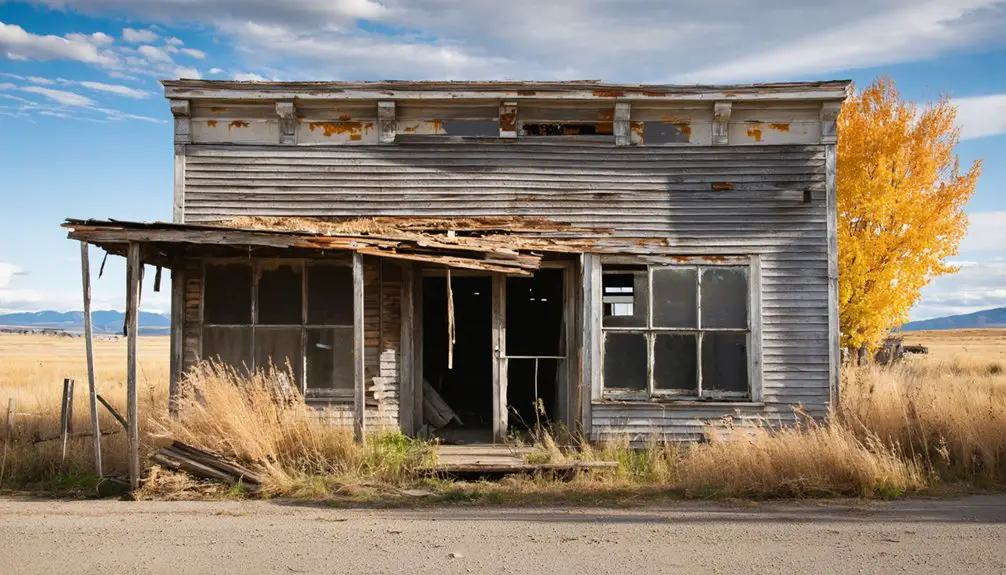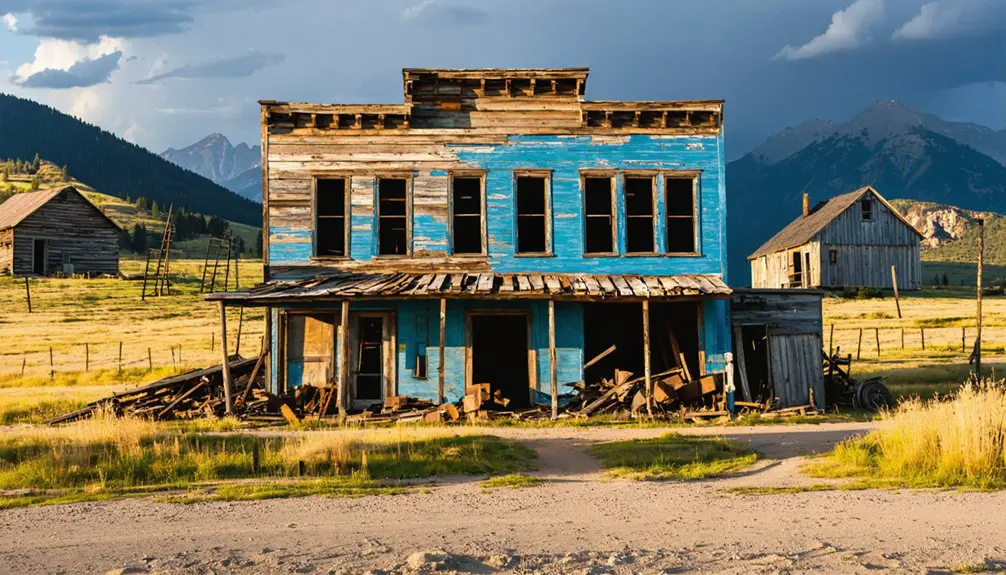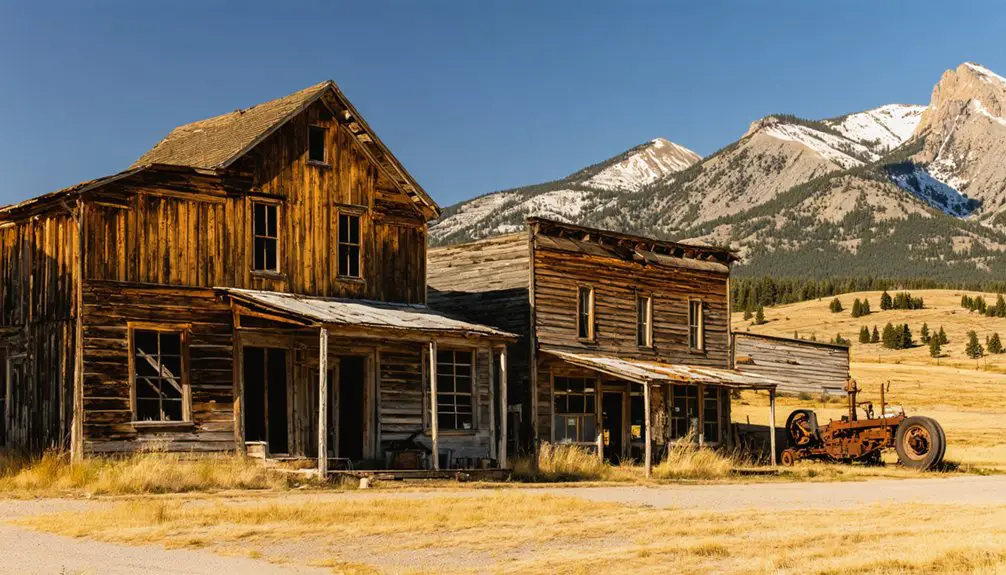You’ll find Landusky ghost town tucked away in Montana’s Little Rocky Mountains, where Pike Landusky’s 1893 gold discovery sparked a mining boom that drew 2,000 residents. The town flourished with log cabins, saloons, and mining operations until fires, economic hardship, and World War II’s impact led to its abandonment. Today, you can explore remnants between Mill and Montana Gulch, where scattered ruins and mining artifacts reveal a fascinating chapter of Montana’s gold rush heritage.
Key Takeaways
- Landusky became a ghost town after the decline of gold mining operations, with its peak population of 2,000 residents dwindling to near abandonment.
- The town’s remaining structures include an old saloon and mining remnants scattered between Mill Gulch and Montana Gulch.
- Access requires high-clearance vehicles via State Road 191 and Ore Street, with visits recommended between late spring and early fall.
- The site preserves authentic remnants of Montana’s gold rush heritage, offering opportunities for historical exploration and photography.
- Originally established after an 1893 gold discovery, Landusky flourished until economic hardships and fires led to its eventual abandonment.
The Rise of a Mining Frontier
When gold placer deposits were discovered in the Landusky area in 1884, a new chapter in Montana’s mining history began.
The rich deposits of gold-silver mineralization associated with the area’s distinctive geology helped drive development in the region.
You’d find numerous small underground mines dotting the landscape from the late 19th century through the 1940s, as frontier spirit drove prospectors to seek their fortunes in the Little Rocky Mountains.
The establishment of the Whitcomb Mill in 1905 marked a significant advancement in mining techniques, providing vital ore processing capabilities for the region.
While the area experienced typical boom-and-bust cycles common to mining towns, determined miners continued their pursuit of gold through various methods.
The introduction of cyanide processing in the early 1900s revolutionized gold extraction and accelerated the development of vein deposits in the area.
Pike Landusky’s Golden Legacy
Behind the town’s namesake lies a tale of frontier ambition and conflict. Powell “Pike” Landusky’s arrival in Montana in 1864 marked the beginning of a legacy that would shape the Little Rocky Mountains.
Pike’s reputation as one of the West’s toughest fighters preceded his remarkable gold discovery in 1893, which transformed the region’s destiny. The discovery led to the controversial Grinnell Agreement of 1895 that transferred gold-rich tribal lands to the U.S. government. His fatal encounter at Jew Jake’s saloon would mark his final chapter in December 1894.
Pike Landusky’s fierce reputation and momentous gold discovery in Montana’s Little Rockies forever changed the course of frontier history.
- You’ll find his influence in the town’s very name, chosen by miners despite opposition from local cattlemen.
- He sparked a gold rush that drew over 2,000 prospectors to the area.
- His conflicts with the Logan brothers, particularly Kid Curry, ended in a fatal 1894 shootout.
- Landusky’s conflicts with both Native Americans and cattlemen highlight the complex social dynamics of Montana’s mining frontier.
The impact of his discovery continues to echo through time, from the Grinnell Agreement to modern-day reclamation efforts.
Life in a Booming Gold Town
Three distinct phases marked life in the booming gold towns of Zortman and Landusky, from rapid growth to peak prosperity to eventual decline.
The discovery of gold by Pike Landusky and Bob Orman in Little Rockies sparked the town’s initial development.
You’d find a bustling community of 2,000 residents during the 1920s peak, with miners and their families living in a mix of log cabins and simple shacks alongside a white clapboard church.
The devastating 1912 destructive fire severely disrupted mining operations and community life, forcing many residents to rebuild their homes and businesses.
Daily life revolved around the mines, where workers faced demanding conditions as mining technology evolved from manual underground work to cyanide heap leaching.
Despite the hardships of long shifts and chemical hazards, community resilience shone through in social gatherings and religious services.
The Ruby Gulch mill’s success, producing up to $14,000 in gold bullion daily, supported local businesses and infrastructure development until the inevitable bust reduced the population to just 60 residents.
Mining Operations and Economic Impact
As mining operations evolved at Landusky from simple placer gold discoveries in 1884 to large-scale industrial extraction, you’d witness a dramatic transformation of both the landscape and local economy.
The introduction of revolutionary mining techniques, including open-pit mining and cyanide heap-leach processing, sparked unprecedented growth from 1977 to 1998. Located 120 miles northeast of Billings, the mine became a significant regional employer.
Here’s what shaped Landusky’s mining boom:
- Ore production skyrocketed from 1.18 million tons in 1980 to 13 million tons by 1994
- Pegasus Gold Corp. pioneered large-scale cyanide heap-leach operations
- Local employment flourished during peak production years
- Environmental challenges emerged, including acid rock drainage and cyanide spills
The mining prosperity wouldn’t last forever. Montana Department of State Lands first approved permits for the operation in 1979.
When Pegasus Gold filed for bankruptcy in 1997, it left behind both an economic void and significant environmental concerns for future generations to address.
The Little Rocky Mountains Gold Rush
The discovery of gold in Montana’s Little Rocky Mountains in 1884 sparked a defining chapter in the region’s history, long before Pegasus Gold’s modern operations would reshape the landscape.
Frank Aldridge made the initial gold discovery on Alder Creek, alongside Pike Landusky and Dutch Lewis, triggering a rush of prospectors to the area.
You’ll find that early mining techniques focused on placer deposits, though many miners barely scraped by. The Plains Indians who had traditionally hunted buffalo in these mountains were gradually displaced by the influx of miners.
The rush brought a lawless atmosphere, with tent saloons and makeshift camps dotting the landscape.
The August mine provided a significant boost when Landusky and Ormond discovered rich deposits there after a decade of searching.
By 1895, a federal agreement opened 49 square miles of land purchased from the Fort Belknap Indian Community, intensifying mining activity.
The region’s geological wealth proved substantial, ultimately yielding over 47 million grams of gold through both placer and hard rock mining operations.
Daily Life and Social Scene
Life in Landusky revolved around its bustling saloons, which served as the town’s social epicenter where miners gathered after grueling shifts to drink, gamble, and sometimes settle disputes with their fists.
Beyond the daily routines of mining and commerce, you’d find a vibrant mix of social gatherings that defined the town’s character.
Here’s what you’d experience in Landusky’s heyday:
- Hotels and boarding houses buzzing with miners, travelers, and newcomers seeking fortune
- Seasonal celebrations during mining breaks, especially during snow-heavy Christmas festivities
- General stores and meat markets serving as community hubs for daily necessities
- Newspapers from nearby Zortman keeping you informed of local happenings
The population peaked at 2,000, creating a lively atmosphere where miners, families, and business owners forged a unique community despite the ever-present threat of violence.
Architecture and Infrastructure

Built from locally sourced timber and native stone, Landusky’s architectural landscape reflected its mining town roots through simple, functional structures that served its growing population.
Simple construction with local materials defined Landusky’s architecture, capturing the utilitarian spirit of a frontier mining settlement.
You’d find log cabins and wood-frame houses with clapboard siding clustered near the mines, while commercial buildings lined the main thoroughfares.
The town’s infrastructure evolution centered on mining operations, featuring the impressive Ruby Gulch mill – once the world’s second-largest cyanide facility.
Support buildings, including assay offices and ore processing facilities, dotted the mountainsides near mine shafts.
You’ll notice the practical architectural styles extended to public buildings like schools, a hospital, and various businesses.
Transportation infrastructure connected Landusky to neighboring communities through roads and tracks, with Rocky Point ford serving as an essential Missouri River crossing point.
The Path to Abandonment
You’ll find that Landusky’s path to abandonment began with the gradual exhaustion of its rich ore veins, leading to a significant decline in mining operations by the early 1900s.
The town’s struggles intensified during both World Wars, when labor shortages and resource restrictions forced many mines to halt production.
These wartime disruptions, combined with devastating fires in 1912 and 1923 that destroyed critical mining infrastructure, accelerated the town’s economic collapse and eventual abandonment by 1951.
Economic Decline Timeline
When gold was discovered near Landusky in 1893 by Pike Landusky and his partner, the area quickly transformed from an untamed wilderness into a bustling mining camp.
The initial ore discovery yielded an impressive $13,000 per ton, sparking rapid development and population growth.
The town’s economic trajectory followed four distinct phases:
- 1893-1900: Peak prosperity with rich ore deposits and minimal mining regulations
- 1900-1950: Gradual decline marked by fires, depleted surface gold, and economic hardships
- 1950-1970: Shift period with reduced underground mining operations
- 1970-Present: Brief revival through corporate mining followed by complete abandonment
War Impact on Mining
The devastating impact of World War II marked a critical turning point for Landusky’s mining operations, as Order L208 forced the immediate suspension of all gold mining activities.
These wartime restrictions dealt a severe blow to the community’s economic foundation, depleting its skilled workforce as miners enlisted in the armed forces.
You’ll find that the war’s aftermath brought even greater challenges.
Post-war gold prices plummeted, making it nearly impossible for mines to achieve profitability.
The prolonged shutdown led to deteriorating infrastructure, while environmental issues like acid drainage and water contamination worsened without proper management.
What was once a thriving town of 2,000 residents saw its population dwindle as the economic consequences of these wartime disruptions rippled through the community, ultimately contributing to Landusky’s transformation into a ghost town.
Exploring the Ghost Town Today

You’ll find Landusky easily accessible via State Road 191, with Ore Street serving as your main entry point into this historic mining settlement.
The town’s remaining structures, including the infamous saloon where Kid Curry shot Pike Landusky, offer compelling subjects for photography and historical documentation.
While exploring the ruins scattered throughout the valley between Mill Gulch and Montana Gulch, you can trace the physical evidence of the town’s gold rush heritage through its abandoned buildings and mining remnants.
Access and Best Routes
Located in Phillips County, Montana, Landusky ghost town requires careful planning and appropriate vehicle preparation to access its remote location.
The primary access routes consist of unpaved gravel and dirt forest roads, with limited signage and cell service throughout the area. You’ll need a high-clearance vehicle, preferably with four-wheel drive, to navigate the challenging driving conditions.
- Plan your visit between late spring and early fall for ideal weather and road conditions
- Download offline maps and GPS coordinates, as cell service is unreliable
- Pack emergency supplies and extra fuel, as services are limited in this remote area
- Check current weather and road conditions before departing, as seasonal closures are common
Building Remains and Ruins
Standing as silent witnesses to Montana’s gold rush era, Landusky’s remaining ruins offer visitors a raw glimpse into the town’s tumultuous past.
You’ll find foundations and partial walls of mining-era buildings scattered across the landscape, including remnants of saloons, miners’ cabins, and Billy Key’s hotel.
Unlike other Montana ghost towns with active ruin preservation efforts, Landusky presents an authentic, unrestored experience.
The weathered remains of log and frame structures reveal traditional construction methods, while stone foundations outline the original town layout.
Though in advanced stages of decay, these ruins hold significant historical significance as tangible links to the area’s mining heritage and violent episodes.
When exploring these unstable structures, you’ll need to exercise caution while examining the architectural remnants of this once-bustling frontier settlement.
Photography and Historic Sites
For photographers seeking to document Montana’s mining heritage, Landusky’s ghost town presents compelling opportunities throughout the year.
The town’s remote location and diverse lighting conditions create ideal settings for photography techniques that capture both historical storytelling and natural beauty.
- You’ll find weathered structures against the Little Rocky Mountains backdrop, perfect for capturing the contrast between human development and wilderness.
- The remnants of saloons and mining operations offer authentic glimpses into 19th-century frontier life.
- Winter snowfall creates dramatic atmospheric effects, while summer light reveals intricate details of remaining artifacts.
- Nearby Zortman’s historic sites complement your photographic exploration of the region’s gold mining era.
Remember to respect private property and preserve these fragile ruins while documenting this significant piece of Montana’s mining history.
Frequently Asked Questions
What Dangerous Wildlife Might Visitors Encounter Around Landusky Today?
You’ll need to watch for mountain lions in the rocky terrain, rattlesnake encounters near old mines, and black bears in wooded areas. Elk can be aggressive during rutting season.
Are There Any Remaining Artifacts That Can Be Legally Collected?
Want to respect history while satisfying your curiosity? You can’t legally collect artifacts here – federal and state laws protect ghost town remains for artifact preservation. Take photos instead of souvenirs.
What Paranormal Activities Have Been Reported in Landusky’s Ghost Town?
You’ll encounter reports of ghost sightings, shadowy figures, and unexplained voices near the saloon where Powell Landusky died. Paranormal investigations have documented cold spots, strange noises, and mysterious equipment malfunctions.
How Accessible Is Landusky During Winter Months?
You’ll face brutal winter accessibility challenges – road conditions can be treacherous with snow and ice. Check MDT’s 511 service before traveling, bring chains, and remember remote roads aren’t regularly plowed.
Are There Any Surviving Descendants of Pike Landusky Still in Montana?
You’ll find no confirmed Pike descendants in Montana today. Despite Landusky history showing he had five children, genealogical records don’t verify any living family members remaining in the state.
References
- https://www.jstor.org/stable/20147100
- https://www.ghosttowns.com/states/mt/landusky.html
- https://westernmininghistory.com/towns/montana/zortman/
- https://visitmt.com/listings/general/ghost-town/town-site-of-zortman-and-landusky
- https://www.mtghosttowns.com/zortman
- https://www.asrs.us/DOI/Proceedings/2009v1/JASMR09011583-Williams.pdf
- https://serc.carleton.edu/research_education/nativelands/ftbelknap/golddeposits.html
- https://serc.carleton.edu/research_education/nativelands/ftbelknap/explorationanddevelopment.html
- https://westernmininghistory.com/mine-detail/10008952/
- https://www.hcn.org/issues/issue-121/montana-on-the-edge-a-fight-over-gold-forces-the-treasure-state-to-confront-its-future/



